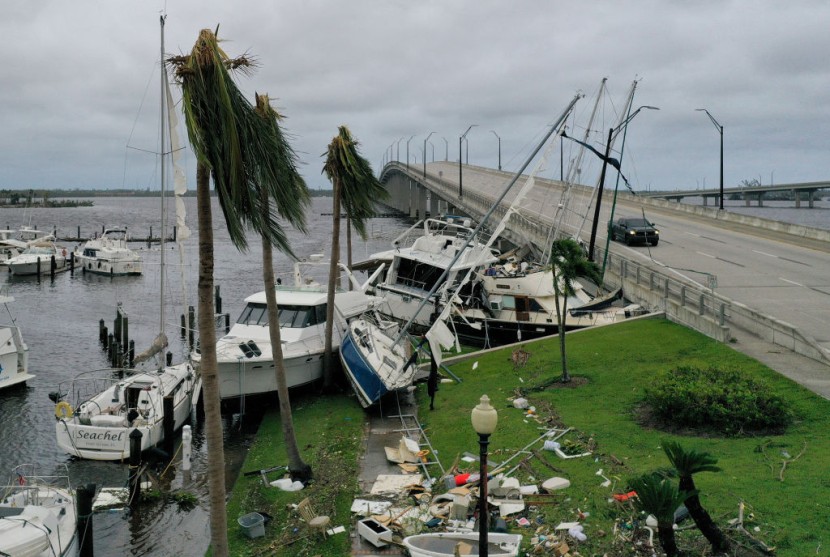
Authorities are still closely monitoring Ian, now a tropical storm, as it continues to move over Florida after it battered the state's west coast as a Category 4 hurricane, leaving millions without electricity and access to potable water.
Search and rescue crews are still responding to hours-old requests for assistance from people trapped due to record-high floods. Early Thursday, survey personnel reported collapsed houses, water, downed power lines, and impassable roads near where Ian touched ashore in Cayo Costa in southern Florida on Wednesday.
Record-Breaking Rains
As Ian went further inland, rising ocean water piled up onshore-up to 12 feet in some places-and 150 mph winds blew, according to a CNN report.
Christopher Burt, a weather historian, says that from 4 a.m. Wednesday to 4 a.m. Thursday, Orlando got 11.94 inches of rain, which broke the record for all of the time. Some areas of the state have already received up to 14 inches of rain.
According to PowerOutage.us, there are about 2.5 million households and businesses without power in Florida as of Thursday morning. Some drinking water systems have either entirely failed or have boil orders in force.
President Biden proclaimed a major disaster for Charlotte, Collier, DeSoto, Hardee, Hillsborough, Lee, Manatee, Pinellas, and Sarasota counties in Florida, ABC News reported.
According to the White House, "Assistance can include grants for temporary housing and house repairs, low-cost loans to cover uninsured property damages, and other initiatives" to help business owners and individuals recuperate from the calamity.
Ian was reduced to a tropical storm early on Thursday with gusts of 65 mph, and by 5 a.m. ET, the storm's core was located 40 miles southeast of Orlando. Ian and Hurricane Charley from 2004 both had 150 mph winds upon landfall, making them the two greatest storms to hit the west coast of the Florida Peninsula.
On the internet, videos of the onslaught of Hurricane Ian have shocked many users in America and across the globe.
Holy cow. Major flooding in Kissimmee. @WFTV #Ian pic.twitter.com/nE6PMzvPoJ
— Nick Papantonis WFTV (@NPapantonisWFTV) September 29, 2022
Currently in Fort Myers, Florida. Video by Loni Architects #flwx #Ian #hurricane pic.twitter.com/8nfncFlG9G
— Kaitlin Wright (@wxkaitlin) September 28, 2022
Lake Lucerne is overflowing, turning the sidewalk and road into a lake. @WFTV pic.twitter.com/oQNO5pWSNw
— Christy Boyd (@christyboyd_) September 29, 2022
East Coast Buckles Up for Ian's Wrath
Tropical storm warnings are still in effect. When the system was weakened, hurricane warnings along the east and west coasts of Florida were reduced to tropical storm warnings. The eastern seaboard issued warnings up to Cape Lookout, North Carolina.
However, various states prepare for Ian's devastation. The east coastlines of other states will be in danger on Thursday as the storm is predicted to move into the Atlantic Ocean. Several governors have already proclaimed states of emergency, including those in Georgia, Virginia, North Carolina, and South Carolina.
After smashing many all-time high storm surge records in places like Naples and Fort Myers, the water levels in Southwest Florida are gradually dropping. On the Atlantic side, from the Flagler-Volusia County line in northeast Florida to the whole Georgia coast to Charleston County, South Carolina, including Florida's St. Johns River, a storm surge warning is still in place over the entire southwest Florida Gulf coast, south of Tampa Bay.
As a result of the rising water flowing inland from the beach, potentially fatal floods might be feared, per The Weather Channel.
5 AM EDT 9/29 Key Messages for Tropical Storm #Ian. More advisory info: https://t.co/tW4KeFW0gB pic.twitter.com/ISkxK07TPq
— National Hurricane Center (@NHC_Atlantic) September 29, 2022
The center of Ian will briefly hit the Atlantic Ocean before turning northwest and making its final impact around the South Carolina coast.
It may temporarily become a minor hurricane before landfall, but its effects will be similar.
Related Article : Hurricane Ian Pummels Florida, Turning Roads Into Rivers and Ripping Buildings Apart While Millions of People Trapped Without Power








